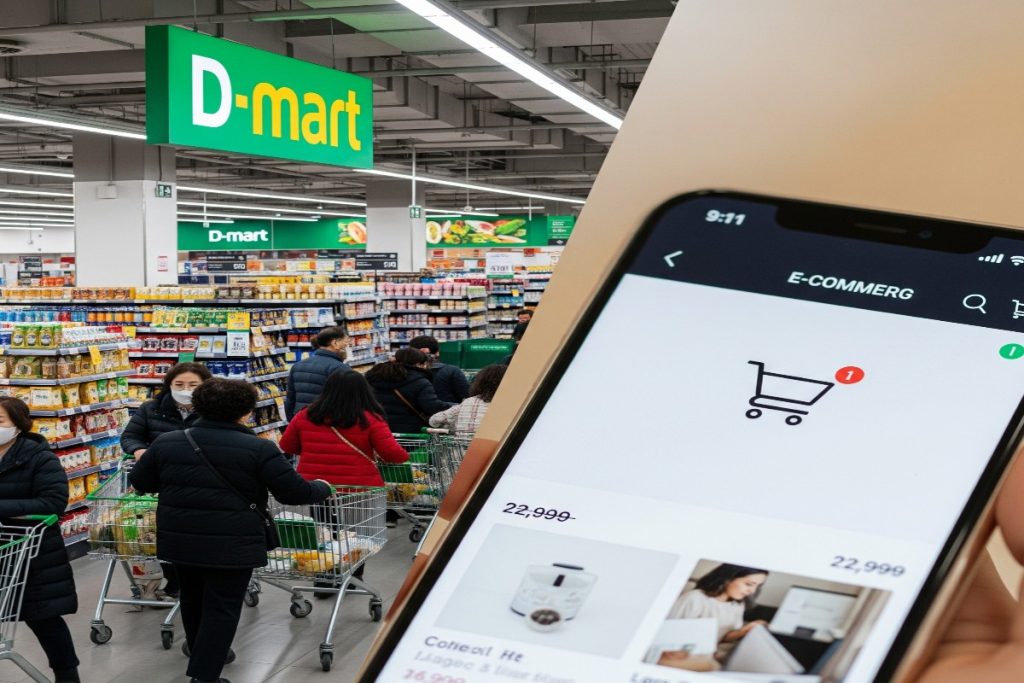Introduction
The competition between online innovators and established giants for the Indian retail sector in 2025 is more intense than ever. D-Mart, a well-known brand with low prices and a large in-store customer base, is located on one side. A increasing number of e-commerce firms, on the other hand, promise anything from same-day fashion delivery to quick groceries.
Nevertheless, D-Mart is still doing well in spite of the digital boom. Why is it still relevant? And can physical stores truly keep up with the speed of internet shopping?
Let’s look at the current spat between D-Mart and e-commerce and its implications for the future of retail.
What Makes D-Mart Still Relevant?
Despite the challenges faced by many physical retailers in the aftermath of the pandemic, D-Mart has not only endured but has also experienced growth. What accounts for this success?
- Efficiency-driven business model: D-Mart upholds rigorous cost management practices, encompassing everything from inventory oversight to the selection of store locations.
- Limited SKU strategy: A reduced number of product variations facilitates quicker turnover and more competitive pricing.
- Customers have a clear understanding of what to expect upon entering a D-Mart: tidy stores, essential merchandise, and significant discounts. This level of predictability is a crucial factor in the brand’s ongoing success, even in an era dominated by online shopping.
In the competition between D-Mart and e-commerce, D-Mart capitalizes on its offline advantages that digital platforms have yet to fully replicate.
Price, Convenience, or Trust What Wins?
The Indian consumer of today is knowledgeable. They understand how to evaluate costs, monitor feedback, and look for discounts. Three key factors shape their purchasing choices: cost, ease, and reliability.
- Price: D-Mart reliably offers lower prices than online flash sales. Its capacity to sell under MRP is unparalleled.
- Convenience: Online shopping excels with home delivery, while D-Mart provides a comprehensive bulk shopping experience for families.
- Trust: D-Mart’s straightforward return policies and quality guarantees enhance its credibility.
Although e-commerce sites frequently advertise significant discounts, concealed shipping costs or pricing unique to the platform can undermine that confidence. D-Mart’s clear pricing continues to be its greatest advantage.

How D-Mart Competes Without Going Fully Online
D-Mart hasn’t fully committed to e-commerce like Reliance or Tata have. Only a few cities with restricted delivery capacity are served via its app, DMart Ready. Nevertheless, the brand is still competitive. In what way?
- Put an emphasis on physical development: In regions with strong demand, D-Mart is adding additional locations.
- Enhanced logistical efficiency: In-store pickup and designated delivery areas lower operating expenses.
- Preventing price wars: It refrains from using unsustainable internet discounts to gain short-term market share.
By avoiding the temptation to imitate e-commerce strategies, D-Mart preserves its profit margins and concentrates on its core competencies. The thing to learn? Being competitive may not always entail copying.
This methodical approach demonstrates that there is still opportunity for innovation in the offline business, hence sustaining the discussion between D-Mart and e-commerce.
The Role of Instant Delivery in Shopping Habits
The most significant advancement in e-commerce in recent years has been the introduction of instant delivery. Urban expectations about time and convenience are changing as a result of companies like Zepto, Blinkit, and Instamart.
However, there are certain aspects they do not replace:
- Monthly stock-up trips that Indian families continue to prefer conducting offline.
- The tactile experience of shopping for products such as clothing, kitchenware, and fresh produce.
- Cultural shopping practices, particularly during festivals and family gatherings.
While online delivery is prevalent for impulse and emergency purchases, bulk shopping for households still tends to favor offline methods. D-Mart recognizes this trend and adjusts its store layouts and discounts accordingly.
Offline Experience vs Online Efficiency
It’s a fact that e-commerce platforms are superior in terms of speed. Can the offline experience be replicated, though?
- In-store finding: Due to their physical exploration of the aisles, many D-Mart customers purchase more than they had intended.
- Ease of bulk purchasing: Using a D-Mart trolley to carry 10 kg bags of grains, detergents, or vegetables is easier than placing many online orders and having them delivered.
- Instant satisfaction: You receive your product in a matter of minutes rather than having to wait two hours or two days.
Conversely, online retailers provide time-saving automation, digital wallets, and tailored suggestions.
In this D-Mart vs. e-commerce conflict, internet promises efficiency while offline offers experience. They currently meet various demands at various times.
What This Battle Means for Retail’s Future
Here is what we can anticipate:
- Hybrid models: Physical retail locations offering online ordering and pick-up services are likely to become the norm.
- Rural versus urban dynamics: D-Mart may maintain its stronghold in semi-urban areas, while e-commerce will concentrate on densely populated cities.
- AI in offline retail: We can look forward to more intelligent checkout systems, tailored in-store promotions, and flexible pricing strategies even in traditional retail environments.
- Sustainability: Physical stores such as D-Mart may perform better regarding packaging waste when compared to home delivery services.
In conclusion, the competition between D-Mart and e-commerce is not solely about one prevailing over the other; rather, it is about how both can develop and coexist. Consumers gain the most when they have access to both alternatives.
Conclusion
By 2025, choosing between online and offline shopping is no longer the only option. It combines pricing, convenience, trust, and experience. D-Mart has demonstrated that conventional business strategies may still succeed by providing reliable value and having a thorough understanding of customer behavior. Shopping carts are still dominated by D-Mart, even though e-commerce may dominate headlines. Professionals may also find their position in this shifting environment with the aid of platforms like Wiraa. Being a top platform for remote work, Wiraa enables people to work from any location, whether they are developing the next big thing in e-commerce or managing logistics in retail. Wiraa is the starting point for the hybrid futures of work and shopping.




